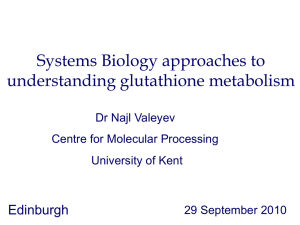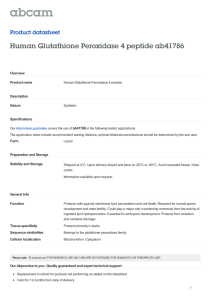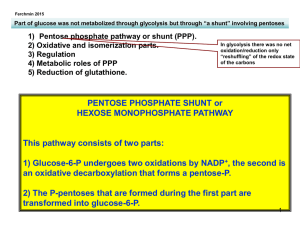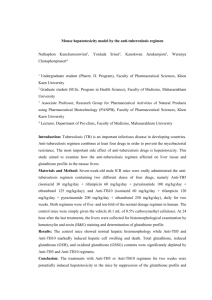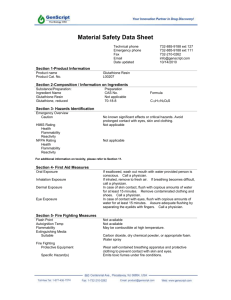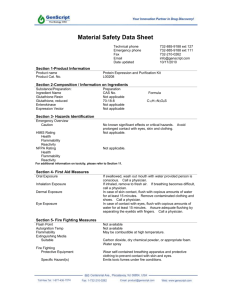c 9
advertisement
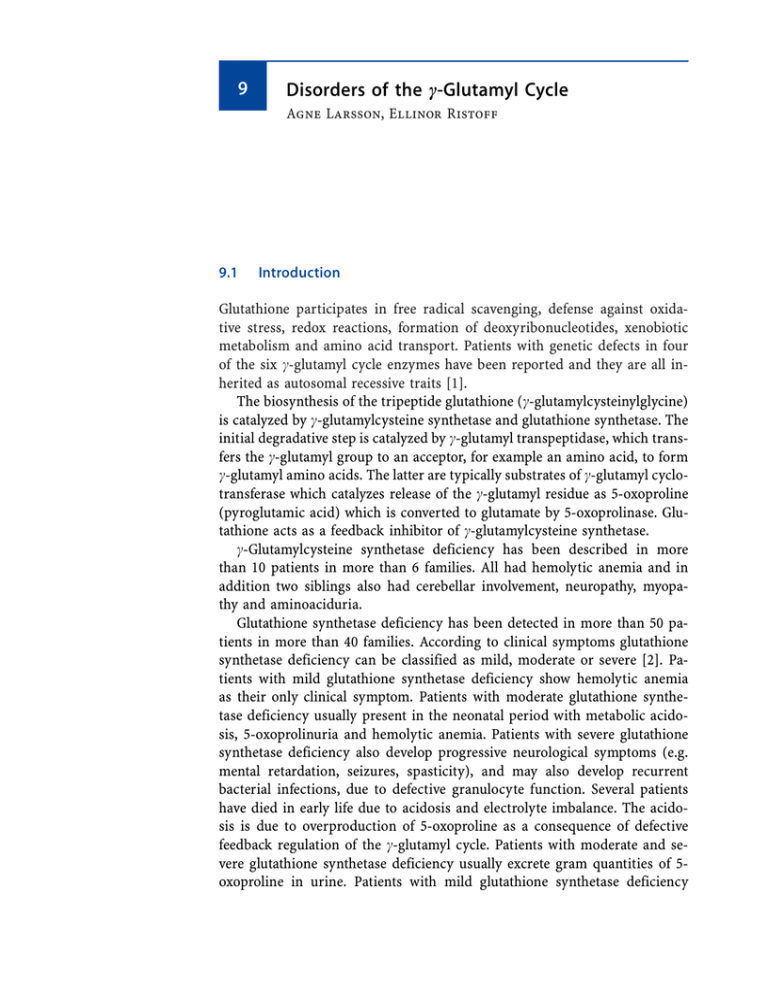
9 Disorders of the c-Glutamyl Cycle Agne Larsson, Ellinor Ristoff 9.1 Introduction Glutathione participates in free radical scavenging, defense against oxidative stress, redox reactions, formation of deoxyribonucleotides, xenobiotic metabolism and amino acid transport. Patients with genetic defects in four of the six c-glutamyl cycle enzymes have been reported and they are all inherited as autosomal recessive traits [1]. The biosynthesis of the tripeptide glutathione (c-glutamylcysteinylglycine) is catalyzed by c-glutamylcysteine synthetase and glutathione synthetase. The initial degradative step is catalyzed by c-glutamyl transpeptidase, which transfers the c-glutamyl group to an acceptor, for example an amino acid, to form c-glutamyl amino acids. The latter are typically substrates of c-glutamyl cyclotransferase which catalyzes release of the c-glutamyl residue as 5-oxoproline (pyroglutamic acid) which is converted to glutamate by 5-oxoprolinase. Glutathione acts as a feedback inhibitor of c-glutamylcysteine synthetase. c-Glutamylcysteine synthetase deficiency has been described in more than 10 patients in more than 6 families. All had hemolytic anemia and in addition two siblings also had cerebellar involvement, neuropathy, myopathy and aminoaciduria. Glutathione synthetase deficiency has been detected in more than 50 patients in more than 40 families. According to clinical symptoms glutathione synthetase deficiency can be classified as mild, moderate or severe [2]. Patients with mild glutathione synthetase deficiency show hemolytic anemia as their only clinical symptom. Patients with moderate glutathione synthetase deficiency usually present in the neonatal period with metabolic acidosis, 5-oxoprolinuria and hemolytic anemia. Patients with severe glutathione synthetase deficiency also develop progressive neurological symptoms (e.g. mental retardation, seizures, spasticity), and may also develop recurrent bacterial infections, due to defective granulocyte function. Several patients have died in early life due to acidosis and electrolyte imbalance. The acidosis is due to overproduction of 5-oxoproline as a consequence of defective feedback regulation of the c-glutamyl cycle. Patients with moderate and severe glutathione synthetase deficiency usually excrete gram quantities of 5oxoproline in urine. Patients with mild glutathione synthetase deficiency 234 Disorders of the c-Glutamyl Cycle maintain cellular levels of glutathione which usually, but not always, is sufficient to prevent accumulation of 5-oxoproline in body fluids. Treatment of patients with glutathione synthetase deficiency includes acidosis correction and supplementation with the anti-oxidants vitamin E, vitamin C and Nacetylcysteine, as well as avoidance of drugs known to precipitate hemolytic crises in patients with glucos-6-phosphate dehydrogenase deficiency. Deficiency of c-glutamylcysteine synthetase or glutathione synthetase results in low intracellular levels of glutathione. This can be demonstrated in erythrocytes, leukocytes and cultured fibroblasts. Increased 5-oxoproline can only be determined via analysis of organic acids by gas chromatography-mass spectrometry (GC-MS). Analysis of the c-glutamyl cycle enzymes in erythrocytes or nucleated cells is required for the diagnosis. The human genes for c-glutamylcysteine synthetase and glutathione synthetase have been mapped and cloned and mutations in the genes have been characterized [1, 3–5]. Prenatal diagnostic evaluation has been practiced for severe glutathione synthetase deficiency using analysis of enzyme activity in chorionic villi and cultured amniocytes, and by analysis of 5-oxoproline levels in amniotic fluid. If the mutant alleles in the family have been identified, prenatal diagnosis can be made by mutation analysis [1]. c-Glutamyl transpeptidase deficiency has been identified in five patients, who excrete glutathione in their urine and have elevated plasma glutathione. Three of the five patients had CNS symptoms. Increased levels of urinary glutathione can be demonstrated by various chromatographic techniques. The human c-glutamyl transpeptidase gene is a multigenetic family with several of its loci located on chromosome 22 [1]. 5-Oxoprolinase deficiency has been identified in eight patients, who lack a consistent clinical syndrome. Urinary excretion of 5-oxoproline is elevated but less than in glutathione synthetase deficiency. Erythrocytes contain an incomplete c-glutamyl cycle; they lack both c-glutamyl transpeptidase and 5-oxoprolinase. 9.2 Nomenclature No. Disorder Tissue distribution Chromosomal location MIM 9.1 c-Glutamylcysteine synthetase deficiency Glutathione synthetase deficiency c-Glutamyl transpeptidase deficiency 5-Oxoprolinase deficiency Universal Heavy subunit 6p12 Light subunit 1p21 20q11.2 230450 9.2 9.3 9.4 Universal Nucleated cells Nucleated cells Multigenic family. Five loci 22 Unknown 266130 231900 231950 260005 Metabolic Pathway 9.3 235 Metabolic Pathway Fig. 9.1. The c-glutamyl cycle for the biosynthesis and degradation of glutathione including known metabolic defects: 9.1, c-glutamylcysteine synthetase; 9.2, glutathione synthetase; 9.3, c-glutamyl transpeptidase; 9.4, 5-oxoprolinase. DP, dipeptidase (cysteinyl glycinase); GGCT, c-glutamyl cyclotransferase. Metabolites that show pathological levels in the various enzymatic defects are marked in bold. Note the role of excess 5-oxoproline (pyroglutamic acid) as a marker for two of the four disorders. 236 Disorders of the c-Glutamyl Cycle 9.4 Signs and Symptoms Table 9.1. c-Glutamylcysteine synthetase deficiency System Symptoms/markers Neonatal Infancy Childhood Adolescence Adulthood Characteristic clinical findings Routine laboratory Jaundice Hemolytic anemia Hemoglobin (B) Reticulocytes (B) Amino aciduria (U) Glutathione (RBC) c-Glutamylcysteine synthetase (RBC, FB) Jaundice Hemolytic anemia Myopathy/weakness Psychosis Ataxia Neuropathy ± + ; : ± ;;; ;;; ± + ; : ± ;;; ;;; ± + ; : ± ;;; ;;; ± + ; : ± ;;; ;;; ± + ; : ± ;;; ;;; ± + ± ± ± ± ± + ± ± ± ± ± + ± ± ± ± ± + ± ± ± ± ± + ± ± ± ± Special laboratory Hematological Musculoskeletal CNS Peripheral nervous system Table 9.2.1. Glutathione synthetase deficiency (mild) System Symptoms/markers Neonatal Infancy Childhood Adolescence Adulthood Characteristic clinical findings Routine laboratory Hemolytic anemia + + + + + Hemoglobin (B) Reticulocytes (B) 5-Oxoproline (U) Glutathione (RBC, FB) c-Glutathione synthetase (RBC, FB) Jaundice Hemolytic anemia ; : N/: ;; ;;; ; : N/: ;; ;;; ; : N/: ;; ;;; ; : N/: ;; ;;; ; : N/: ;; ;;; ± + ± + ± + ± + ± + Special laboratory Hematological Signs and Symptoms 237 Table 9.2.2. Glutathione synthetase deficiency (moderate, severe) System Symptoms/markers Neonatal Infancy Childhood Adolescence Adulthood Characteristic clinical findings Hemolytic anemia Metabolic acidosis Neurological symptoms Recurrent bacterial infections Acidosis (B) Hemoglobin (B) Reticulocytes (B) 5-Oxoproline (U) Glutathione (RBC, FB) c-Glutathione synthetase (RBC, FB) Psychomotor or mental retardation Seizures Hyper-/hypotonia Ataxia Myopathy/weakness Jaundice Hemolytic anemia Recurrent bacterial infections Retinal pigmentations Crystalline opacities in the lens Impaired dark adaptation + + ± ± + + ± ± + + ± ± + + ± ± + + ± ± + ; : :/::: ;; ;;; + ; : :/::: ;; ;;; + ; : :/::: ;; ;;; + ; : :/::: ;; ;;; + ; : :/::: ;; ;;; ± ± ± ± ± ± ± ± ± ± ± ± + ± ± ± ± ± ± + ± ± ± ± ± ± + ± ± ± ± ± ± + ± ± ± ± ± ± ± ± ± ± Routine laboratory Special laboratory CNS Musculoskeletal Hematological Immune system Eye ± ± + ± Table 9.3. c-Glutamyl transpeptidase deficiency System Symptoms/markers Characteristic clinical findings Special laboratory No consistent clinical picture CNS Glutathione (U) Glutathione (RBC, FB) Glutathione (P) c-Glutamyl transpeptidase (WBC, FB) Mental retardation Psychosis Neonatal Infancy Childhood Adolescence Adulthood : N : ; : N : ; : N : ; : N : ; : N : ; ± ± ± ± ± ± 238 Disorders of the c-Glutamyl Cycle Table 9.4. 5-Oxoprolinase deficiency System Symptoms/markers Characteristic clinical findings Routine laboratory Special laboratory No consistent clinical picture CNS Renal GI 9.5 Acicosis (B) 5-Oxoproline (U) 5-Oxoprolinase (LYM, FB) Psychomotor or mental retardation Microcephaly Urolithiasis Renal colic Colitis Diarrhea Neonatal Infancy Childhood Adolescence Adulthood N : ; ± N : ; ± N : ; ± N : ; ± N : ; ± ± ± ± ± ± ± ± ± ± ± ± ± Reference Values 5-Oxoproline (U) <10 mmol/mol creat Glutathione (RBC) 4.6–10.9 nmol/mg of hemoglobin 9.6 Pathological Values/Differential Diagnosis Variant Glutathione 9.1 c-Glutamylcysteine synthetase deficiency 9.2.1 Glutathione synthetase deficiency; mild 9.2.2 Glutathione synthetase deficiency; moderate/severe 9.3 c-Glutamyltranspeptidase deficiency 9.4 5-Oxoprolinase deficiency 9.7 Loading Tests Not applicable. (RBC, B) (U) (P) 5-Oxoproline (U) Acid-base Reticulobalance cytes (B) (B) ;; N N N : ;; N N/: N : ;; N ::: Acidosis : N : : N N N N N N : N N Diagnostic Flow Chart 9.8 Diagnostic Flow Chart Fig. 9.2. Diagnostic flow chart for disorders of the c-glutamyl cycle. 239 240 Disorders of the c-Glutamyl Cycle 9.9 Specimen Collection Test Preconditions Material Handling Glutathione – RBC, B, FB c-Glutamylcysteine synthetase Glutathione synthetase c-Glutamyl transpeptidase c-Glutamyl cyclotransferase 5-Oxoprolinase 5-Oxoproline – Frozen (–20 8C) Assays that do not detect oxidized glutathione tend to underestimate glutathione in stored samples Frozen (–20 8C) RBC, LYM, FB RBC, LYM, Frozen (–20 8C) FB WBC, FB, (P) Frozen (–20 8C) – – – – – Mutation analy- – sis (DNA sequencing) RBC, WBC, FB WBC, FB U Pitfalls Frozen (–20 8C) Frozen (–20 8C) Frozen (–20 8C) Excretion of 5-oxoproline has been found in patients with inborn errors of metabolism outside the c-glutamyl cycle (e.g. homocystinuria OCT deficiency) and in patients receiving certain drugs (vigabatrin, paracetamol) and specific diets (acid hydrolyzed protein formula) FB, WBC, CV, Cells in culture Prenatal diagnosis is greatly AFC (room tempera- facilitated if the mutant alture) lele/s in the specific family are known 9.10 Prenatal Diagnosis Prenatal diagnosis is greatly facilitated if the mutant allele/s in the specific family are known. Disorder Tissue Timing, trimester 9.2.2 CV AF AFC I II II Summary/Comments 241 9.11 DNA Analysis Disorder Tissue Methodology 9.1 9.2.1, 9.2.2 FB, WBC, LYM FB, WBC, LYM, CV, AFC DNA sequencing DNA sequencing 9.12 Initial Treatment Defects that lead to decreased levels of glutathione can be treated according to two complementary strategies: avoidance of drugs that lead to oxidative stress, and supplementation with compounds that may act as free-radical scavengers (e.g. vitamin C, vitamin E and N-acetylcysteine). The only disorder of the c-glutamyl cycle for which treatment principles have been developed is glutathione synthetase deficiency (9.2) [1]. The initial symptoms in the neonatal period may be metabolic acidosis and jaundice. Acidosis usually needs to be corrected with sodium bicarbonate, THAM or sodium citrate. Patients may benefit from oral administration of vitamin E (10 mg/kg/day) and vitamin C (100 mg/kg/day). Trials have also been made with N-acetylcysteine and glutathione esters which increased glutathione in leukocytes and plasma. Both these compounds lead to increased intracellular levels of glutathione. However, no decrease in the excretion of 5-oxoprolinuria has been reported. Patients who are deficient in c-glutamylcysteine synthetase or glutathione synthetase should avoid drugs that can induce hemolytic crises in patients with glucose-6-phosphate dehydrogenase deficiency, e.g. phenobarbital, acetylsalicylic acid, sulfonamides. 9.13 Summary/Comments In the c-glutamyl cycle, hereditary defects have been detected in four of the six enzymes: c-glutamylcysteine synthetase, glutathione synthetase, c-glutamyl transpeptidase and 5-oxoprolinase. A single patient with tentative deficiency of dipeptidase (cysteinylglycinase) has recently been reported [6]. Deficiency of either of the two synthetases results in decreased levels of glutathione and thus increased sensitivity to oxidative stress which results in hemolytic anemia. Glutathione synthetase deficiency occurs with different severity; the mild form is only associated with hemolytic anemia, whereas moderate and severe glutathione synthetase deficiency is associated also with metabolic acidosis, progressive neurological symptoms and recurrent bacterial infections. 5-Oxoproline (pyroglutamic acid) is overproduced in glutathione synthetase deficiency due to lack of feedback inhibi- 242 Disorders of the c-Glutamyl Cycle tion. Treatment involves acidosis correction, administration of vitamin E, vitamin C, N-acetylcysteine, and avoidance of drugs inducing hemolysis. cGlutamyl transpeptidase deficiency is associated with glutathionuria and 5oxoprolinase deficiency with 5-oxoprolinuria. References 1. Larsson A, Anderson ME (2001) Glutathione synthetase deficiency and other disorders of the c-glutamyl cycle, in The Metabolic and Molecular Bases of Inherited Disease, 8th edn (eds Scriver, Beaudet, Sly and Valle, Vogelstein & Childs), McGrawHill, New York, pp 2205–2216 2. Beutler E, Gelbart T, Kondo T, Matsunaga AT (1999) The molecular basis of a case of gamma-glutamylcysteine synthetase deficiency. Blood 94: 2890 3. Ristoff E, Augustson C, Geissler J, de Rijk T, Carlsson K, Luo J-L, Andersson K, Weening RS, van Zwieten R, Larsson A, Roos D (2000) A missense mutation in the heavy subunit of c-glutamylcysteine synthetase deficiency causes hemolytic anemia. Blood 95(7): 2193–2196. 4. Ristoff E, Mayatepek E, Larsson A (2001) Long-term clinical outcome in patients with glutathione synthetase deficiency. J Ped 139(1): 79–84. 5. Njålsson R, Carlsson K, Olin B, Carlsson B, Whitbred A, Polekhina G, Parker MW, Norgren S, Mannervik B, Board P, Larsson A (2000) Analysis of key missense mutations in patients with glutathione synthetase deficiency. Biochem. J. 349: 275–279. 6. Bellet H, Rejou F, Vallat C, Mion H, Dimeglio A (1999) Cystinylglycinuria: A new neurometabolic disorder? J Inher Metab Dis 22: 231–234


